Impact of Globalisation on Nestle's Recruitment, Selection, Training
VerifiedAdded on 2021/01/01
|29
|5538
|189
Report
AI Summary
This report examines how multinational companies, specifically Nestle, adapt their recruitment, selection, and training practices to meet international requirements in a globalized world. The introduction provides background on globalization and its impact on businesses. Task 1 outlines the project's aims, objectives, and research questions, followed by a detailed project management plan, including cost analysis, scope definition, timeframes, quality control, communication strategies, risk assessment, and resource allocation. A work breakdown structure and Gantt chart are also presented. Task 2 delves into qualitative and quantitative research methods, describing data collection through primary and secondary sources, with a focus on a questionnaire-based survey. The report also explores the importance of globalisation for Nestle, evaluates its recruitment and selection processes, and analyzes training strategies. Finally, the report provides recommendations and a performance review, leading to a conclusion and a list of references.
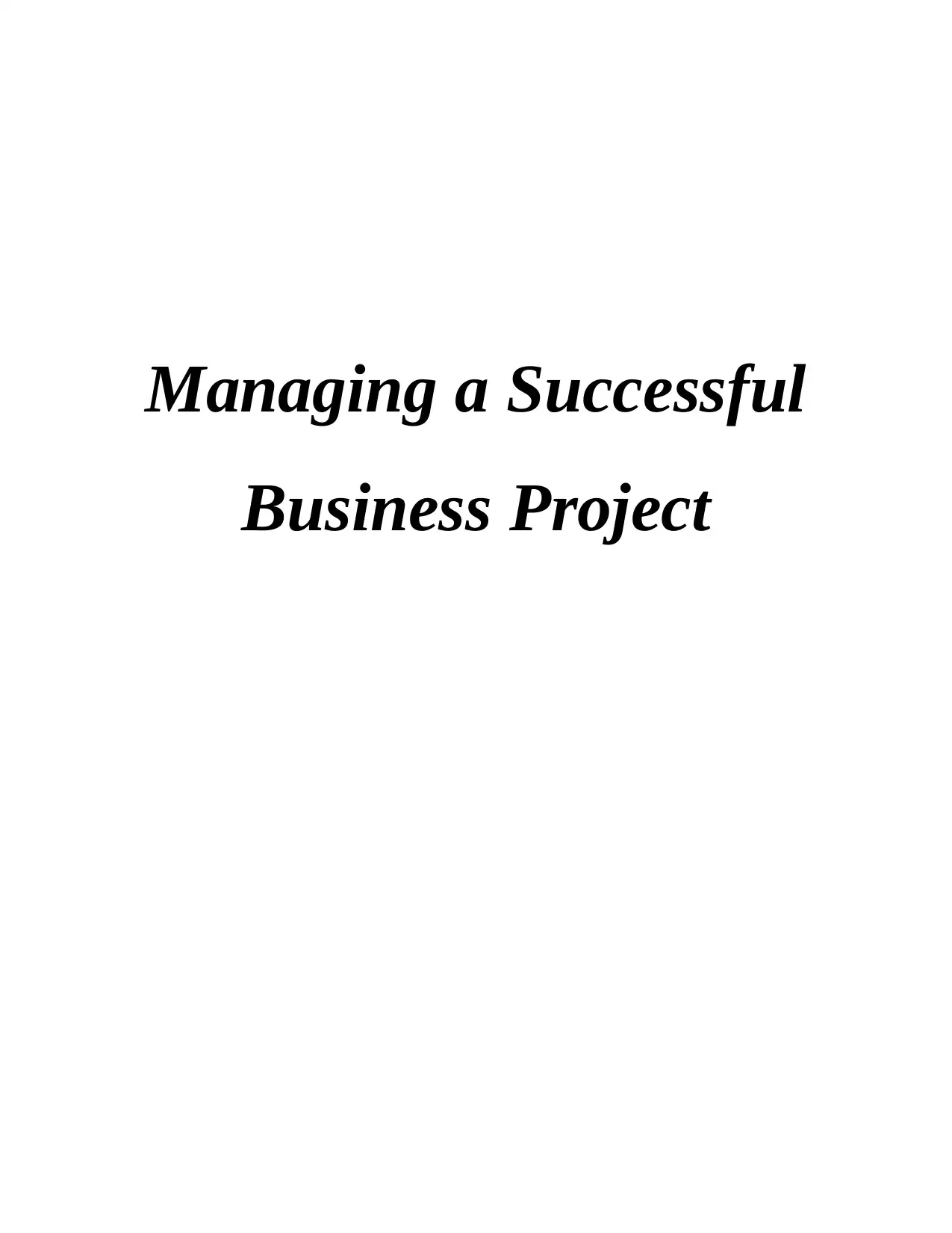
Managing a Successful
Business Project
Business Project
Paraphrase This Document
Need a fresh take? Get an instant paraphrase of this document with our AI Paraphraser
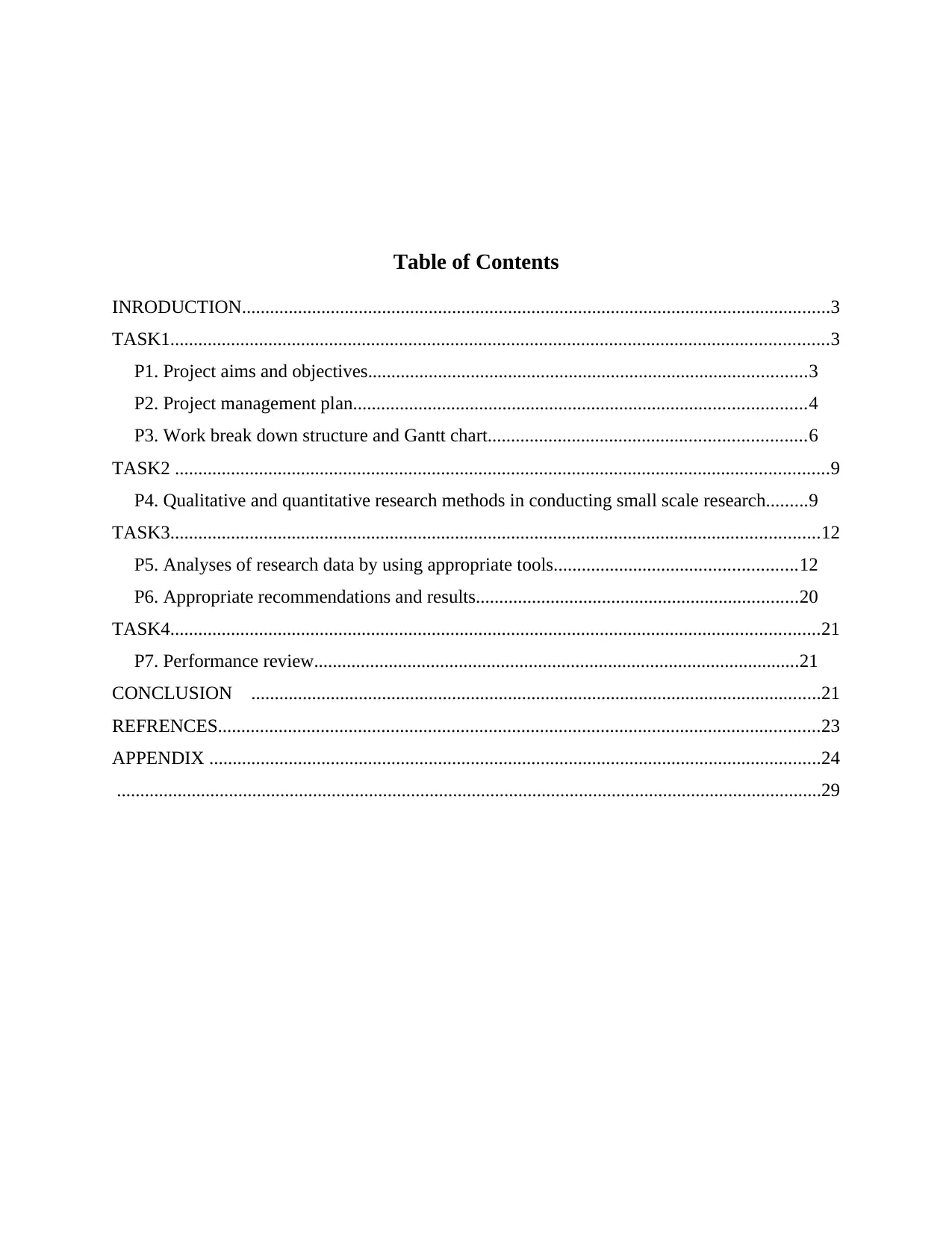
Table of Contents
INRODUCTION..............................................................................................................................3
TASK1.............................................................................................................................................3
P1. Project aims and objectives..............................................................................................3
P2. Project management plan.................................................................................................4
P3. Work break down structure and Gantt chart....................................................................6
TASK2 ............................................................................................................................................9
P4. Qualitative and quantitative research methods in conducting small scale research.........9
TASK3...........................................................................................................................................12
P5. Analyses of research data by using appropriate tools....................................................12
P6. Appropriate recommendations and results.....................................................................20
TASK4...........................................................................................................................................21
P7. Performance review........................................................................................................21
CONCLUSION ..........................................................................................................................21
REFRENCES.................................................................................................................................23
APPENDIX ...................................................................................................................................24
.......................................................................................................................................................29
INRODUCTION..............................................................................................................................3
TASK1.............................................................................................................................................3
P1. Project aims and objectives..............................................................................................3
P2. Project management plan.................................................................................................4
P3. Work break down structure and Gantt chart....................................................................6
TASK2 ............................................................................................................................................9
P4. Qualitative and quantitative research methods in conducting small scale research.........9
TASK3...........................................................................................................................................12
P5. Analyses of research data by using appropriate tools....................................................12
P6. Appropriate recommendations and results.....................................................................20
TASK4...........................................................................................................................................21
P7. Performance review........................................................................................................21
CONCLUSION ..........................................................................................................................21
REFRENCES.................................................................................................................................23
APPENDIX ...................................................................................................................................24
.......................................................................................................................................................29
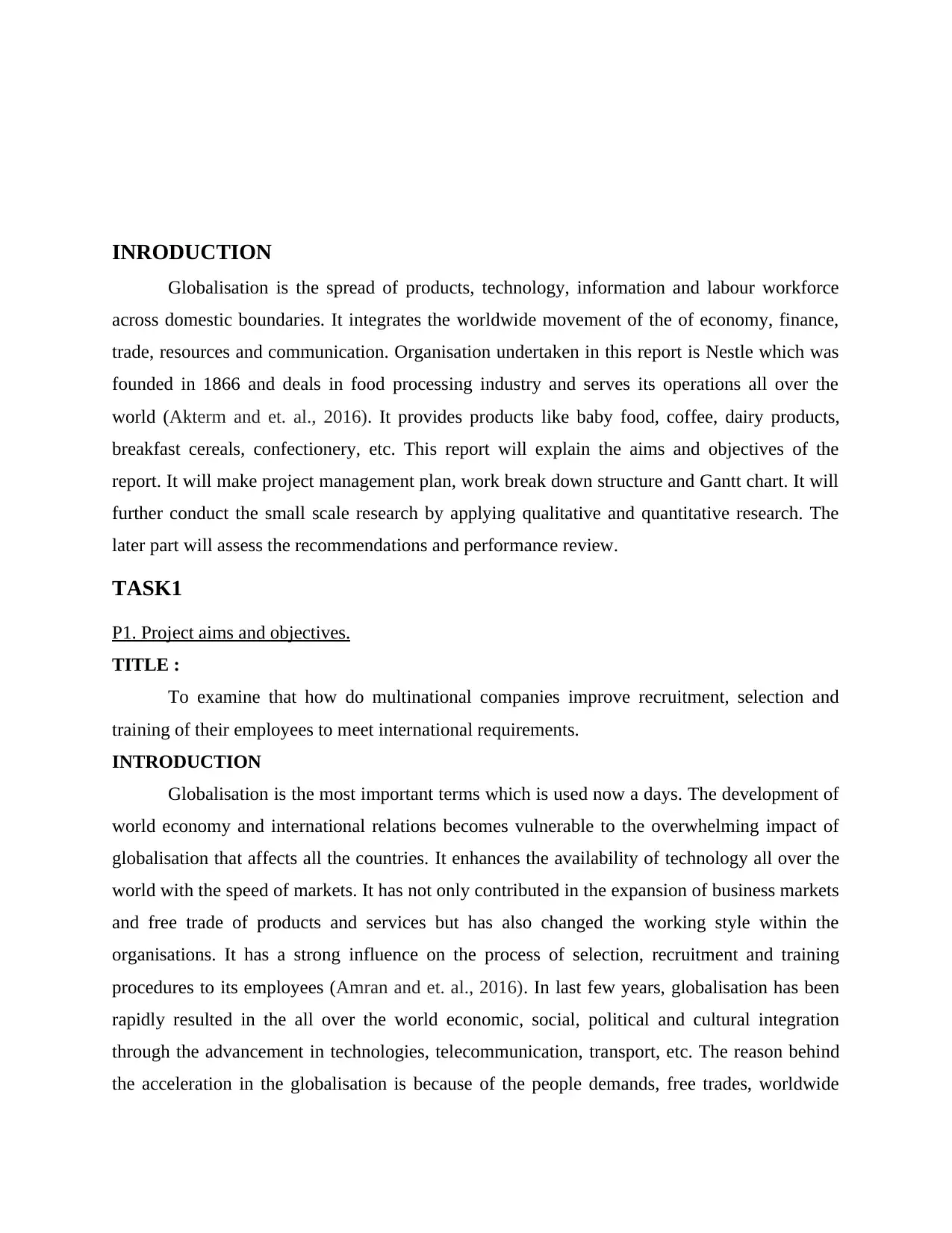
INRODUCTION
Globalisation is the spread of products, technology, information and labour workforce
across domestic boundaries. It integrates the worldwide movement of the of economy, finance,
trade, resources and communication. Organisation undertaken in this report is Nestle which was
founded in 1866 and deals in food processing industry and serves its operations all over the
world (Akterm and et. al., 2016). It provides products like baby food, coffee, dairy products,
breakfast cereals, confectionery, etc. This report will explain the aims and objectives of the
report. It will make project management plan, work break down structure and Gantt chart. It will
further conduct the small scale research by applying qualitative and quantitative research. The
later part will assess the recommendations and performance review.
TASK1
P1. Project aims and objectives.
TITLE :
To examine that how do multinational companies improve recruitment, selection and
training of their employees to meet international requirements.
INTRODUCTION
Globalisation is the most important terms which is used now a days. The development of
world economy and international relations becomes vulnerable to the overwhelming impact of
globalisation that affects all the countries. It enhances the availability of technology all over the
world with the speed of markets. It has not only contributed in the expansion of business markets
and free trade of products and services but has also changed the working style within the
organisations. It has a strong influence on the process of selection, recruitment and training
procedures to its employees (Amran and et. al., 2016). In last few years, globalisation has been
rapidly resulted in the all over the world economic, social, political and cultural integration
through the advancement in technologies, telecommunication, transport, etc. The reason behind
the acceleration in the globalisation is because of the people demands, free trades, worldwide
Globalisation is the spread of products, technology, information and labour workforce
across domestic boundaries. It integrates the worldwide movement of the of economy, finance,
trade, resources and communication. Organisation undertaken in this report is Nestle which was
founded in 1866 and deals in food processing industry and serves its operations all over the
world (Akterm and et. al., 2016). It provides products like baby food, coffee, dairy products,
breakfast cereals, confectionery, etc. This report will explain the aims and objectives of the
report. It will make project management plan, work break down structure and Gantt chart. It will
further conduct the small scale research by applying qualitative and quantitative research. The
later part will assess the recommendations and performance review.
TASK1
P1. Project aims and objectives.
TITLE :
To examine that how do multinational companies improve recruitment, selection and
training of their employees to meet international requirements.
INTRODUCTION
Globalisation is the most important terms which is used now a days. The development of
world economy and international relations becomes vulnerable to the overwhelming impact of
globalisation that affects all the countries. It enhances the availability of technology all over the
world with the speed of markets. It has not only contributed in the expansion of business markets
and free trade of products and services but has also changed the working style within the
organisations. It has a strong influence on the process of selection, recruitment and training
procedures to its employees (Amran and et. al., 2016). In last few years, globalisation has been
rapidly resulted in the all over the world economic, social, political and cultural integration
through the advancement in technologies, telecommunication, transport, etc. The reason behind
the acceleration in the globalisation is because of the people demands, free trades, worldwide
⊘ This is a preview!⊘
Do you want full access?
Subscribe today to unlock all pages.

Trusted by 1+ million students worldwide
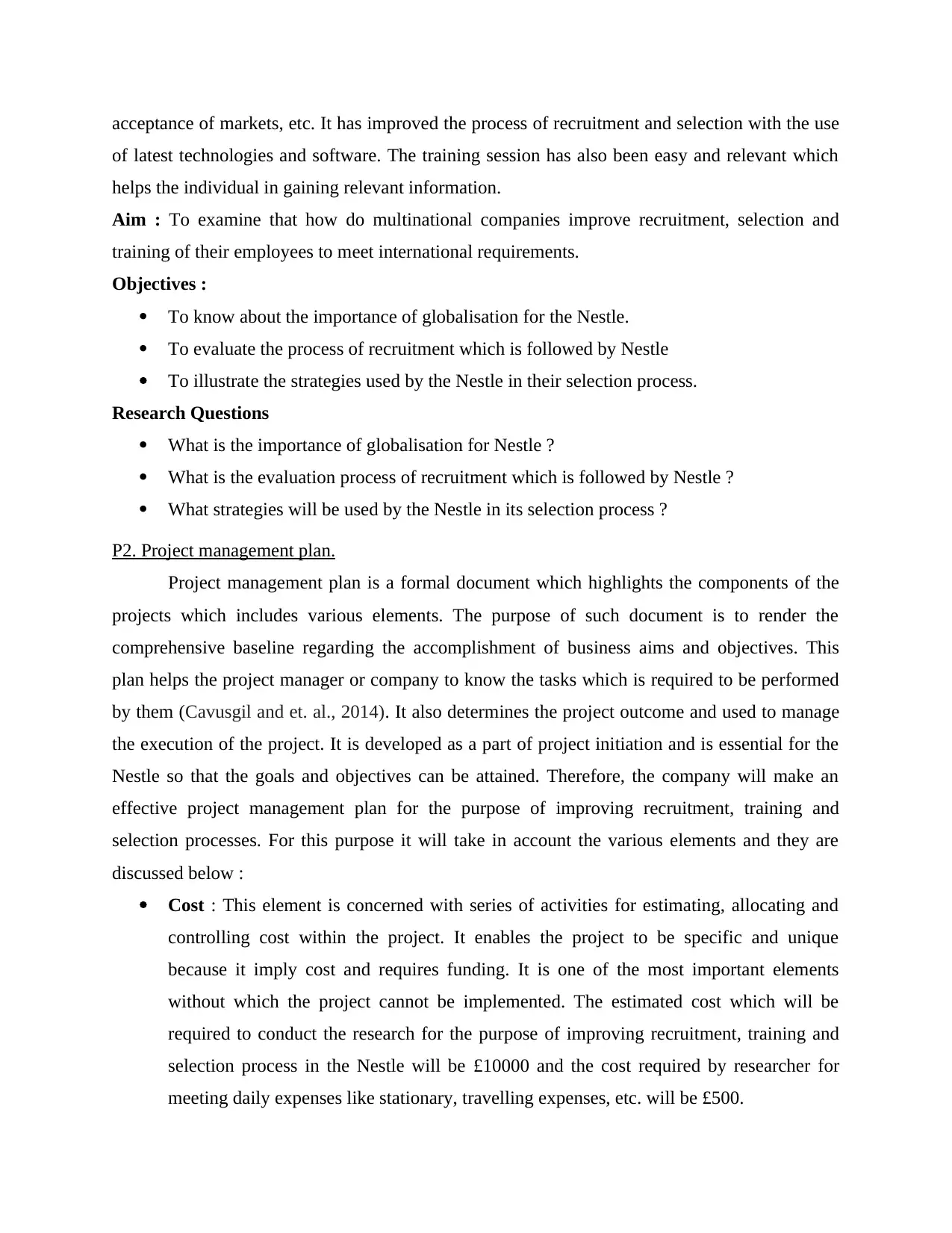
acceptance of markets, etc. It has improved the process of recruitment and selection with the use
of latest technologies and software. The training session has also been easy and relevant which
helps the individual in gaining relevant information.
Aim : To examine that how do multinational companies improve recruitment, selection and
training of their employees to meet international requirements.
Objectives :
To know about the importance of globalisation for the Nestle.
To evaluate the process of recruitment which is followed by Nestle
To illustrate the strategies used by the Nestle in their selection process.
Research Questions
What is the importance of globalisation for Nestle ?
What is the evaluation process of recruitment which is followed by Nestle ?
What strategies will be used by the Nestle in its selection process ?
P2. Project management plan.
Project management plan is a formal document which highlights the components of the
projects which includes various elements. The purpose of such document is to render the
comprehensive baseline regarding the accomplishment of business aims and objectives. This
plan helps the project manager or company to know the tasks which is required to be performed
by them (Cavusgil and et. al., 2014). It also determines the project outcome and used to manage
the execution of the project. It is developed as a part of project initiation and is essential for the
Nestle so that the goals and objectives can be attained. Therefore, the company will make an
effective project management plan for the purpose of improving recruitment, training and
selection processes. For this purpose it will take in account the various elements and they are
discussed below :
Cost : This element is concerned with series of activities for estimating, allocating and
controlling cost within the project. It enables the project to be specific and unique
because it imply cost and requires funding. It is one of the most important elements
without which the project cannot be implemented. The estimated cost which will be
required to conduct the research for the purpose of improving recruitment, training and
selection process in the Nestle will be £10000 and the cost required by researcher for
meeting daily expenses like stationary, travelling expenses, etc. will be £500.
of latest technologies and software. The training session has also been easy and relevant which
helps the individual in gaining relevant information.
Aim : To examine that how do multinational companies improve recruitment, selection and
training of their employees to meet international requirements.
Objectives :
To know about the importance of globalisation for the Nestle.
To evaluate the process of recruitment which is followed by Nestle
To illustrate the strategies used by the Nestle in their selection process.
Research Questions
What is the importance of globalisation for Nestle ?
What is the evaluation process of recruitment which is followed by Nestle ?
What strategies will be used by the Nestle in its selection process ?
P2. Project management plan.
Project management plan is a formal document which highlights the components of the
projects which includes various elements. The purpose of such document is to render the
comprehensive baseline regarding the accomplishment of business aims and objectives. This
plan helps the project manager or company to know the tasks which is required to be performed
by them (Cavusgil and et. al., 2014). It also determines the project outcome and used to manage
the execution of the project. It is developed as a part of project initiation and is essential for the
Nestle so that the goals and objectives can be attained. Therefore, the company will make an
effective project management plan for the purpose of improving recruitment, training and
selection processes. For this purpose it will take in account the various elements and they are
discussed below :
Cost : This element is concerned with series of activities for estimating, allocating and
controlling cost within the project. It enables the project to be specific and unique
because it imply cost and requires funding. It is one of the most important elements
without which the project cannot be implemented. The estimated cost which will be
required to conduct the research for the purpose of improving recruitment, training and
selection process in the Nestle will be £10000 and the cost required by researcher for
meeting daily expenses like stationary, travelling expenses, etc. will be £500.
Paraphrase This Document
Need a fresh take? Get an instant paraphrase of this document with our AI Paraphraser
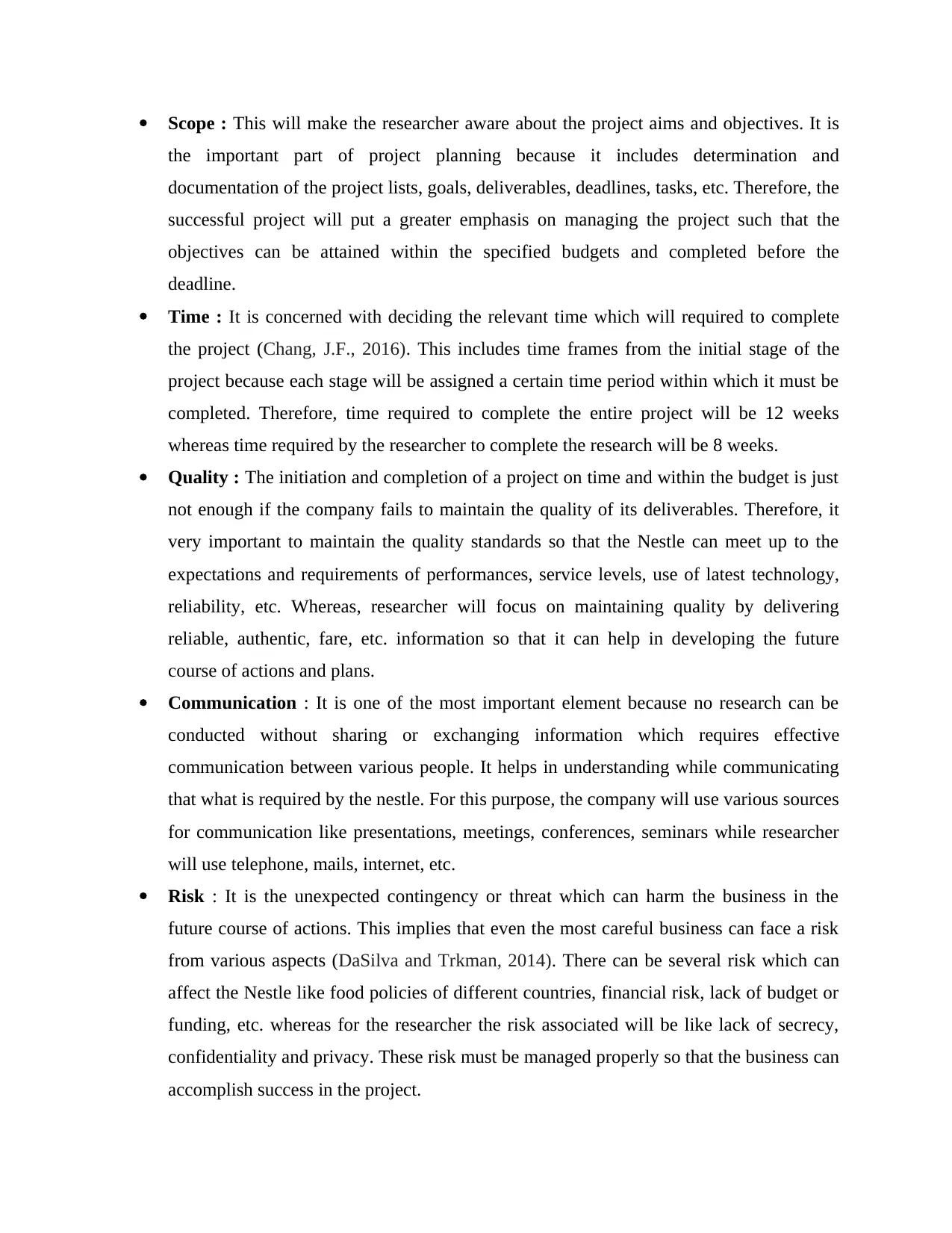
Scope : This will make the researcher aware about the project aims and objectives. It is
the important part of project planning because it includes determination and
documentation of the project lists, goals, deliverables, deadlines, tasks, etc. Therefore, the
successful project will put a greater emphasis on managing the project such that the
objectives can be attained within the specified budgets and completed before the
deadline.
Time : It is concerned with deciding the relevant time which will required to complete
the project (Chang, J.F., 2016). This includes time frames from the initial stage of the
project because each stage will be assigned a certain time period within which it must be
completed. Therefore, time required to complete the entire project will be 12 weeks
whereas time required by the researcher to complete the research will be 8 weeks.
Quality : The initiation and completion of a project on time and within the budget is just
not enough if the company fails to maintain the quality of its deliverables. Therefore, it
very important to maintain the quality standards so that the Nestle can meet up to the
expectations and requirements of performances, service levels, use of latest technology,
reliability, etc. Whereas, researcher will focus on maintaining quality by delivering
reliable, authentic, fare, etc. information so that it can help in developing the future
course of actions and plans.
Communication : It is one of the most important element because no research can be
conducted without sharing or exchanging information which requires effective
communication between various people. It helps in understanding while communicating
that what is required by the nestle. For this purpose, the company will use various sources
for communication like presentations, meetings, conferences, seminars while researcher
will use telephone, mails, internet, etc.
Risk : It is the unexpected contingency or threat which can harm the business in the
future course of actions. This implies that even the most careful business can face a risk
from various aspects (DaSilva and Trkman, 2014). There can be several risk which can
affect the Nestle like food policies of different countries, financial risk, lack of budget or
funding, etc. whereas for the researcher the risk associated will be like lack of secrecy,
confidentiality and privacy. These risk must be managed properly so that the business can
accomplish success in the project.
the important part of project planning because it includes determination and
documentation of the project lists, goals, deliverables, deadlines, tasks, etc. Therefore, the
successful project will put a greater emphasis on managing the project such that the
objectives can be attained within the specified budgets and completed before the
deadline.
Time : It is concerned with deciding the relevant time which will required to complete
the project (Chang, J.F., 2016). This includes time frames from the initial stage of the
project because each stage will be assigned a certain time period within which it must be
completed. Therefore, time required to complete the entire project will be 12 weeks
whereas time required by the researcher to complete the research will be 8 weeks.
Quality : The initiation and completion of a project on time and within the budget is just
not enough if the company fails to maintain the quality of its deliverables. Therefore, it
very important to maintain the quality standards so that the Nestle can meet up to the
expectations and requirements of performances, service levels, use of latest technology,
reliability, etc. Whereas, researcher will focus on maintaining quality by delivering
reliable, authentic, fare, etc. information so that it can help in developing the future
course of actions and plans.
Communication : It is one of the most important element because no research can be
conducted without sharing or exchanging information which requires effective
communication between various people. It helps in understanding while communicating
that what is required by the nestle. For this purpose, the company will use various sources
for communication like presentations, meetings, conferences, seminars while researcher
will use telephone, mails, internet, etc.
Risk : It is the unexpected contingency or threat which can harm the business in the
future course of actions. This implies that even the most careful business can face a risk
from various aspects (DaSilva and Trkman, 2014). There can be several risk which can
affect the Nestle like food policies of different countries, financial risk, lack of budget or
funding, etc. whereas for the researcher the risk associated will be like lack of secrecy,
confidentiality and privacy. These risk must be managed properly so that the business can
accomplish success in the project.
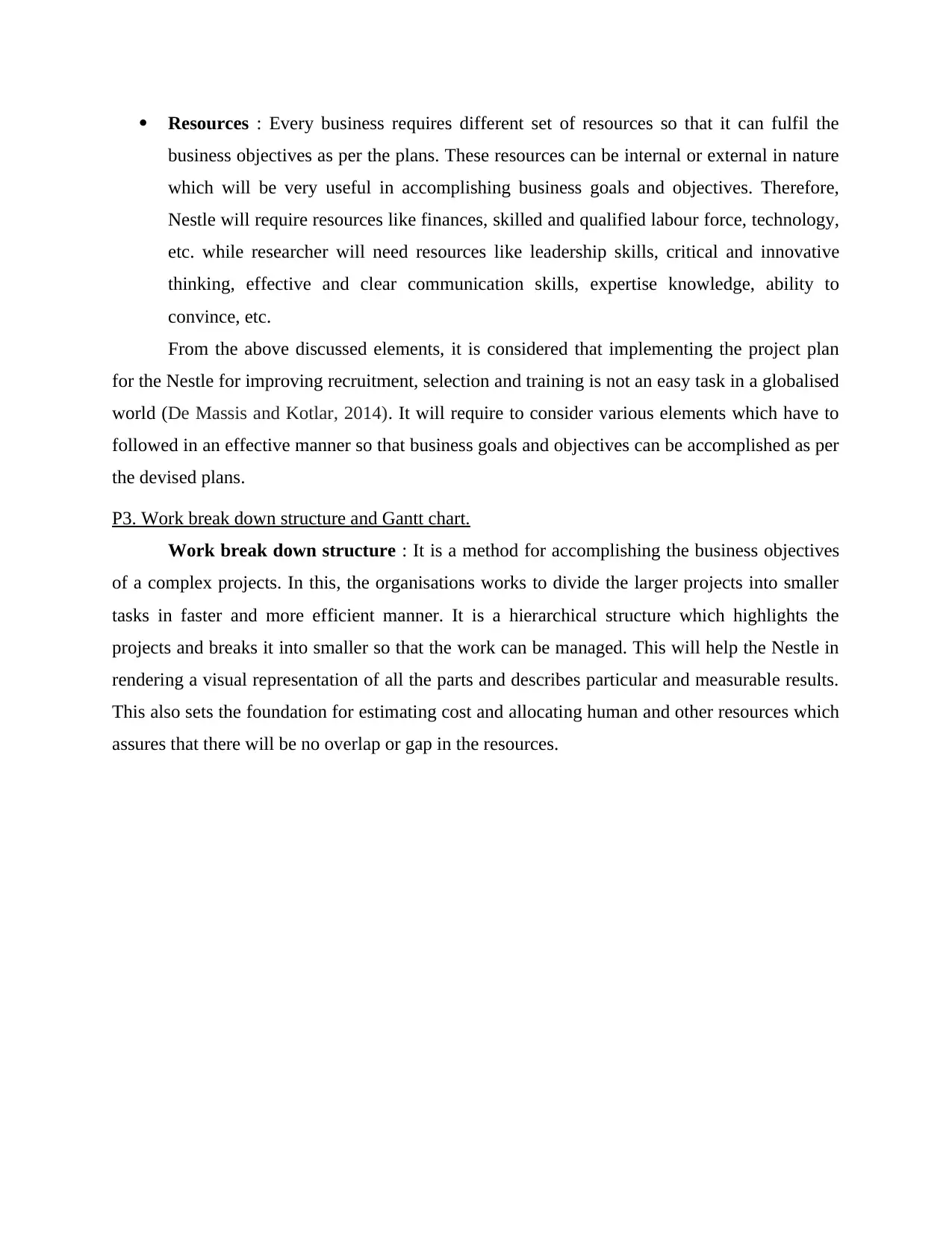
Resources : Every business requires different set of resources so that it can fulfil the
business objectives as per the plans. These resources can be internal or external in nature
which will be very useful in accomplishing business goals and objectives. Therefore,
Nestle will require resources like finances, skilled and qualified labour force, technology,
etc. while researcher will need resources like leadership skills, critical and innovative
thinking, effective and clear communication skills, expertise knowledge, ability to
convince, etc.
From the above discussed elements, it is considered that implementing the project plan
for the Nestle for improving recruitment, selection and training is not an easy task in a globalised
world (De Massis and Kotlar, 2014). It will require to consider various elements which have to
followed in an effective manner so that business goals and objectives can be accomplished as per
the devised plans.
P3. Work break down structure and Gantt chart.
Work break down structure : It is a method for accomplishing the business objectives
of a complex projects. In this, the organisations works to divide the larger projects into smaller
tasks in faster and more efficient manner. It is a hierarchical structure which highlights the
projects and breaks it into smaller so that the work can be managed. This will help the Nestle in
rendering a visual representation of all the parts and describes particular and measurable results.
This also sets the foundation for estimating cost and allocating human and other resources which
assures that there will be no overlap or gap in the resources.
business objectives as per the plans. These resources can be internal or external in nature
which will be very useful in accomplishing business goals and objectives. Therefore,
Nestle will require resources like finances, skilled and qualified labour force, technology,
etc. while researcher will need resources like leadership skills, critical and innovative
thinking, effective and clear communication skills, expertise knowledge, ability to
convince, etc.
From the above discussed elements, it is considered that implementing the project plan
for the Nestle for improving recruitment, selection and training is not an easy task in a globalised
world (De Massis and Kotlar, 2014). It will require to consider various elements which have to
followed in an effective manner so that business goals and objectives can be accomplished as per
the devised plans.
P3. Work break down structure and Gantt chart.
Work break down structure : It is a method for accomplishing the business objectives
of a complex projects. In this, the organisations works to divide the larger projects into smaller
tasks in faster and more efficient manner. It is a hierarchical structure which highlights the
projects and breaks it into smaller so that the work can be managed. This will help the Nestle in
rendering a visual representation of all the parts and describes particular and measurable results.
This also sets the foundation for estimating cost and allocating human and other resources which
assures that there will be no overlap or gap in the resources.
⊘ This is a preview!⊘
Do you want full access?
Subscribe today to unlock all pages.

Trusted by 1+ million students worldwide
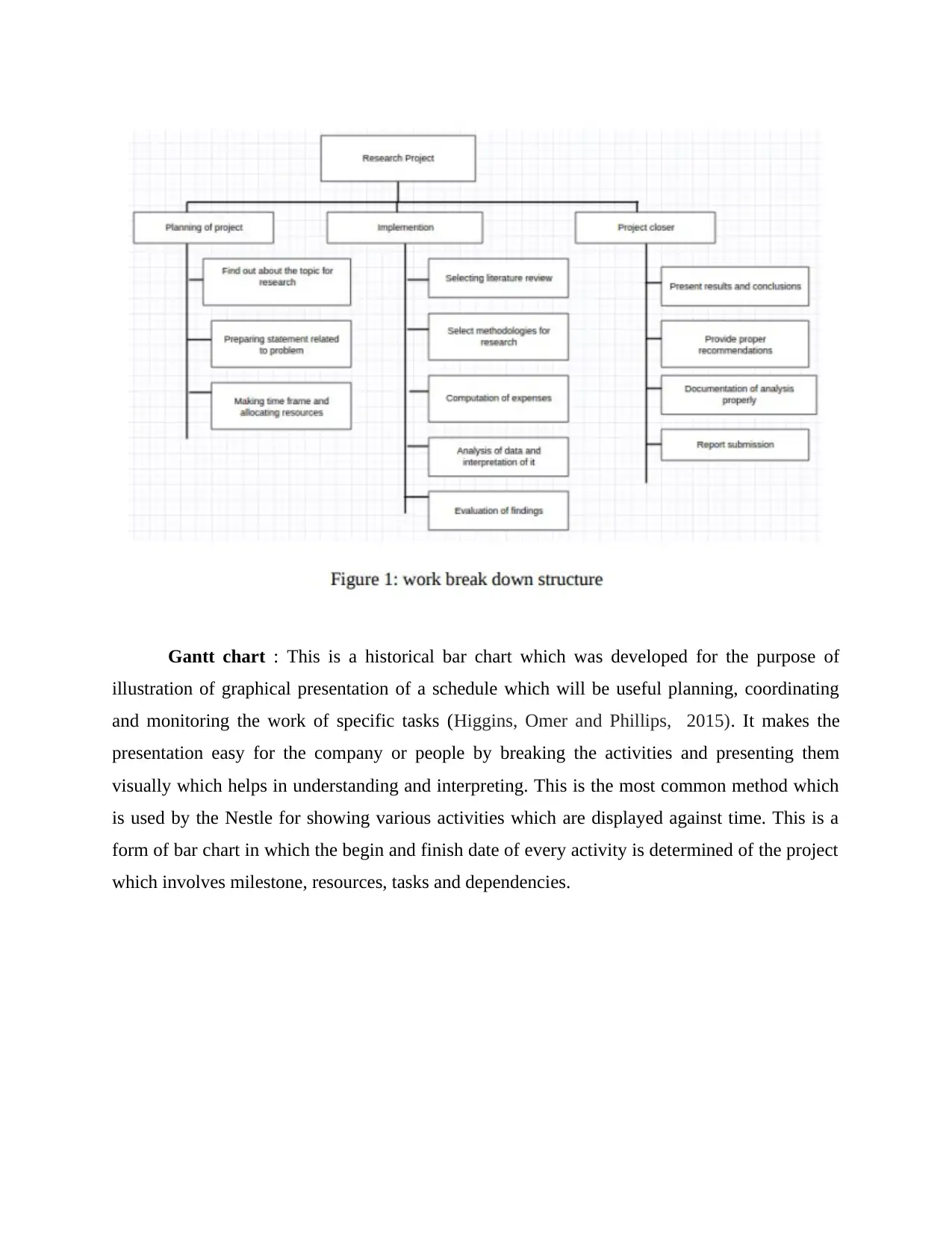
Gantt chart : This is a historical bar chart which was developed for the purpose of
illustration of graphical presentation of a schedule which will be useful planning, coordinating
and monitoring the work of specific tasks (Higgins, Omer and Phillips, 2015). It makes the
presentation easy for the company or people by breaking the activities and presenting them
visually which helps in understanding and interpreting. This is the most common method which
is used by the Nestle for showing various activities which are displayed against time. This is a
form of bar chart in which the begin and finish date of every activity is determined of the project
which involves milestone, resources, tasks and dependencies.
illustration of graphical presentation of a schedule which will be useful planning, coordinating
and monitoring the work of specific tasks (Higgins, Omer and Phillips, 2015). It makes the
presentation easy for the company or people by breaking the activities and presenting them
visually which helps in understanding and interpreting. This is the most common method which
is used by the Nestle for showing various activities which are displayed against time. This is a
form of bar chart in which the begin and finish date of every activity is determined of the project
which involves milestone, resources, tasks and dependencies.
Paraphrase This Document
Need a fresh take? Get an instant paraphrase of this document with our AI Paraphraser
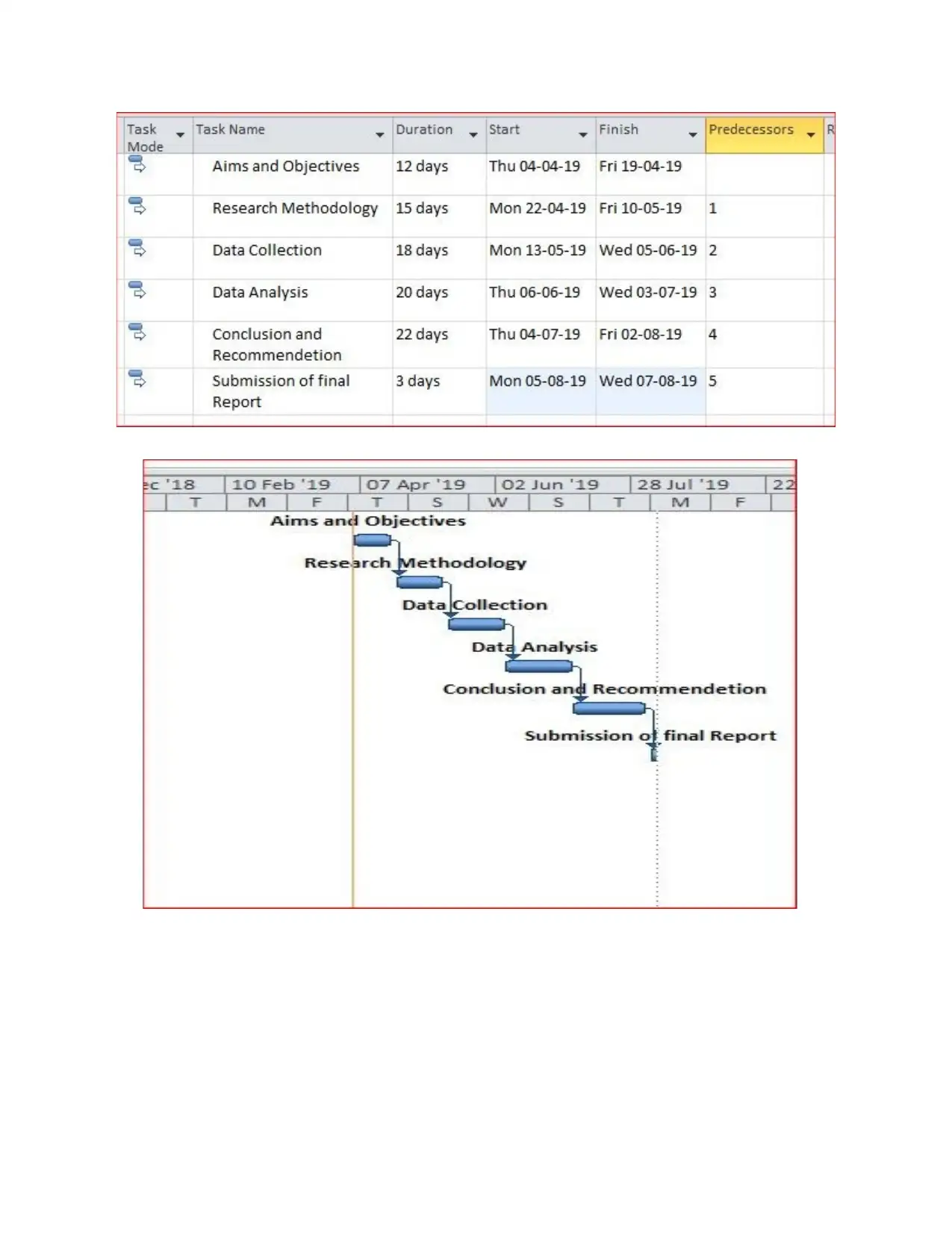
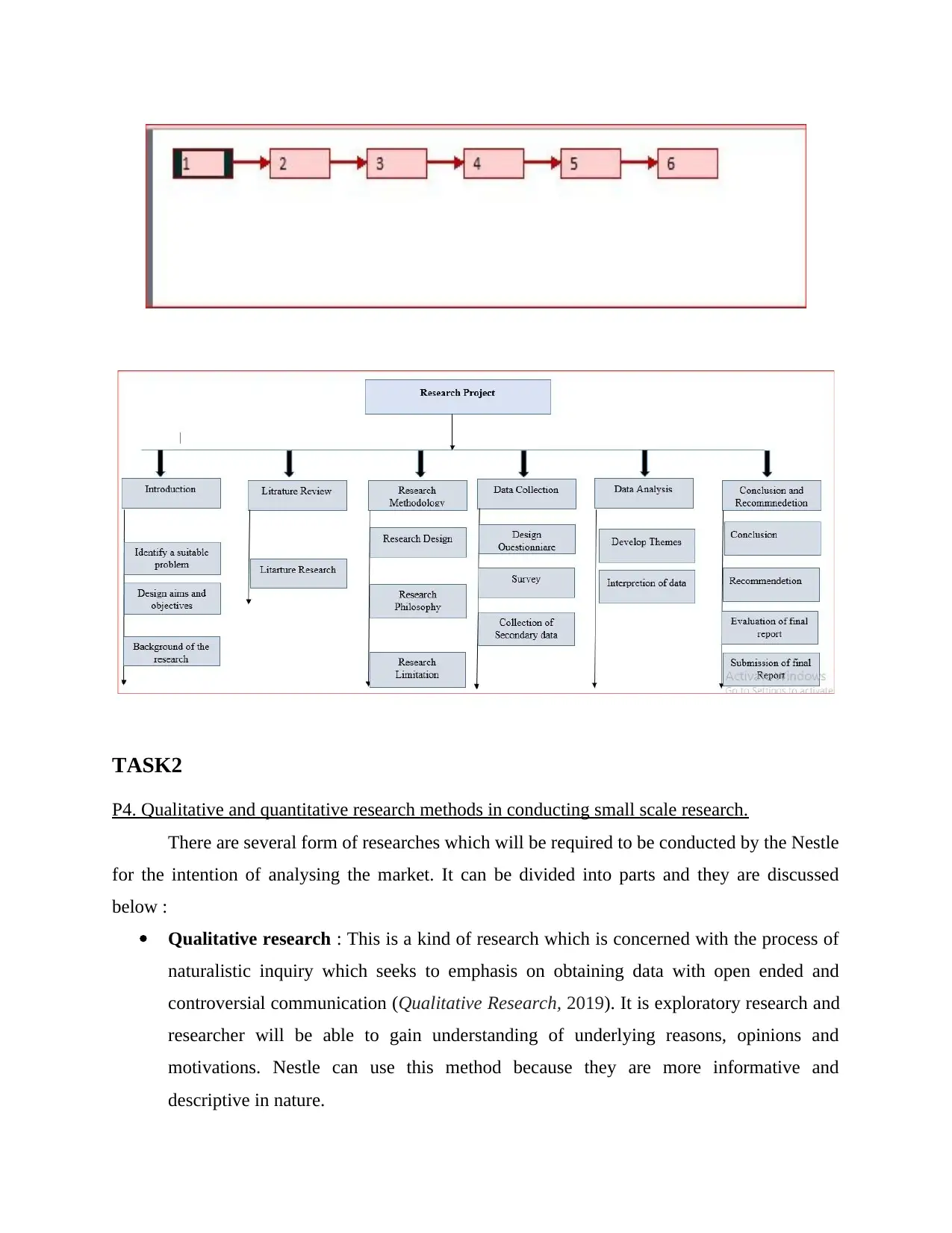
TASK2
P4. Qualitative and quantitative research methods in conducting small scale research.
There are several form of researches which will be required to be conducted by the Nestle
for the intention of analysing the market. It can be divided into parts and they are discussed
below :
Qualitative research : This is a kind of research which is concerned with the process of
naturalistic inquiry which seeks to emphasis on obtaining data with open ended and
controversial communication (Qualitative Research, 2019). It is exploratory research and
researcher will be able to gain understanding of underlying reasons, opinions and
motivations. Nestle can use this method because they are more informative and
descriptive in nature.
P4. Qualitative and quantitative research methods in conducting small scale research.
There are several form of researches which will be required to be conducted by the Nestle
for the intention of analysing the market. It can be divided into parts and they are discussed
below :
Qualitative research : This is a kind of research which is concerned with the process of
naturalistic inquiry which seeks to emphasis on obtaining data with open ended and
controversial communication (Qualitative Research, 2019). It is exploratory research and
researcher will be able to gain understanding of underlying reasons, opinions and
motivations. Nestle can use this method because they are more informative and
descriptive in nature.
⊘ This is a preview!⊘
Do you want full access?
Subscribe today to unlock all pages.

Trusted by 1+ million students worldwide
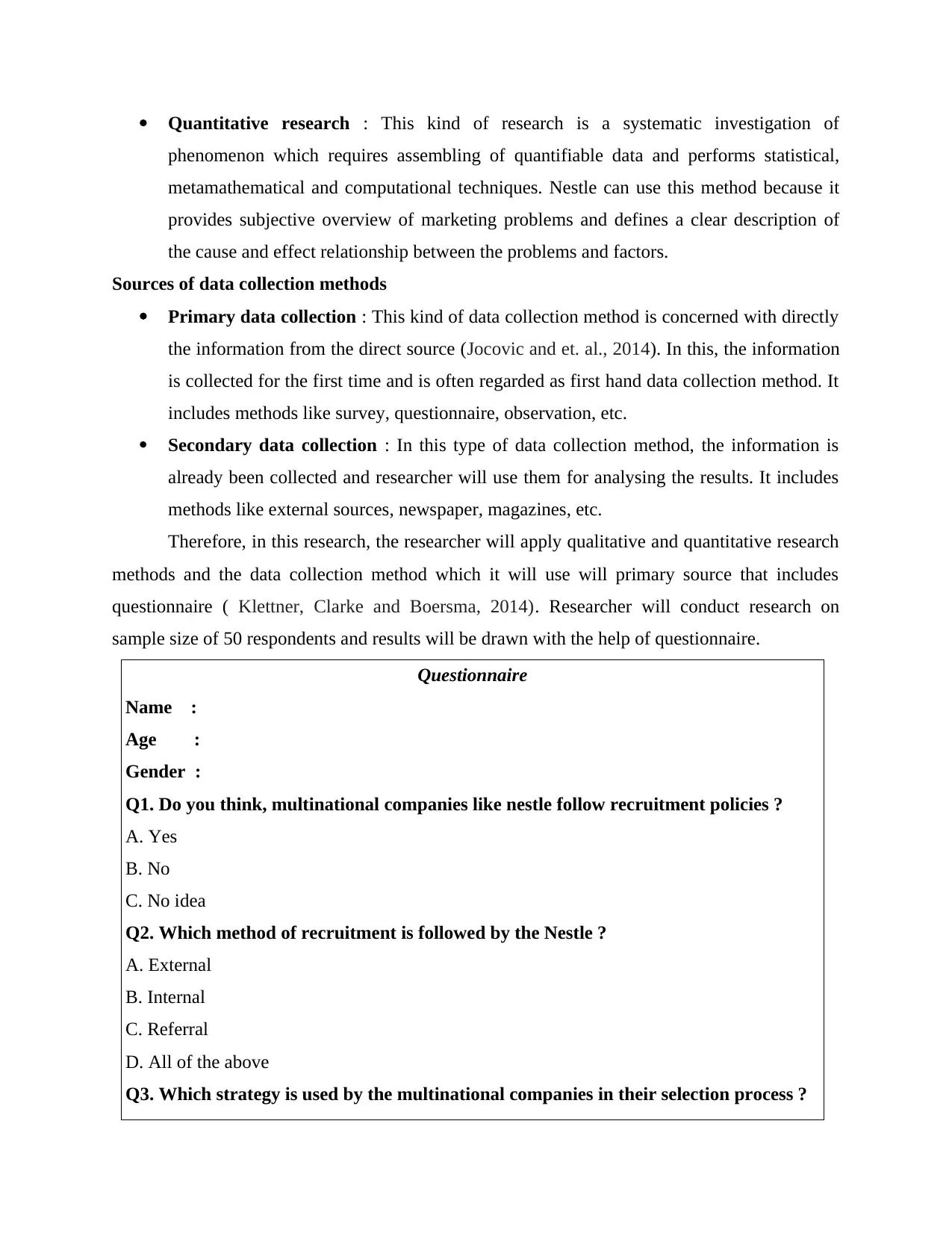
Quantitative research : This kind of research is a systematic investigation of
phenomenon which requires assembling of quantifiable data and performs statistical,
metamathematical and computational techniques. Nestle can use this method because it
provides subjective overview of marketing problems and defines a clear description of
the cause and effect relationship between the problems and factors.
Sources of data collection methods
Primary data collection : This kind of data collection method is concerned with directly
the information from the direct source (Jocovic and et. al., 2014). In this, the information
is collected for the first time and is often regarded as first hand data collection method. It
includes methods like survey, questionnaire, observation, etc.
Secondary data collection : In this type of data collection method, the information is
already been collected and researcher will use them for analysing the results. It includes
methods like external sources, newspaper, magazines, etc.
Therefore, in this research, the researcher will apply qualitative and quantitative research
methods and the data collection method which it will use will primary source that includes
questionnaire ( Klettner, Clarke and Boersma, 2014). Researcher will conduct research on
sample size of 50 respondents and results will be drawn with the help of questionnaire.
Questionnaire
Name :
Age :
Gender :
Q1. Do you think, multinational companies like nestle follow recruitment policies ?
A. Yes
B. No
C. No idea
Q2. Which method of recruitment is followed by the Nestle ?
A. External
B. Internal
C. Referral
D. All of the above
Q3. Which strategy is used by the multinational companies in their selection process ?
phenomenon which requires assembling of quantifiable data and performs statistical,
metamathematical and computational techniques. Nestle can use this method because it
provides subjective overview of marketing problems and defines a clear description of
the cause and effect relationship between the problems and factors.
Sources of data collection methods
Primary data collection : This kind of data collection method is concerned with directly
the information from the direct source (Jocovic and et. al., 2014). In this, the information
is collected for the first time and is often regarded as first hand data collection method. It
includes methods like survey, questionnaire, observation, etc.
Secondary data collection : In this type of data collection method, the information is
already been collected and researcher will use them for analysing the results. It includes
methods like external sources, newspaper, magazines, etc.
Therefore, in this research, the researcher will apply qualitative and quantitative research
methods and the data collection method which it will use will primary source that includes
questionnaire ( Klettner, Clarke and Boersma, 2014). Researcher will conduct research on
sample size of 50 respondents and results will be drawn with the help of questionnaire.
Questionnaire
Name :
Age :
Gender :
Q1. Do you think, multinational companies like nestle follow recruitment policies ?
A. Yes
B. No
C. No idea
Q2. Which method of recruitment is followed by the Nestle ?
A. External
B. Internal
C. Referral
D. All of the above
Q3. Which strategy is used by the multinational companies in their selection process ?
Paraphrase This Document
Need a fresh take? Get an instant paraphrase of this document with our AI Paraphraser
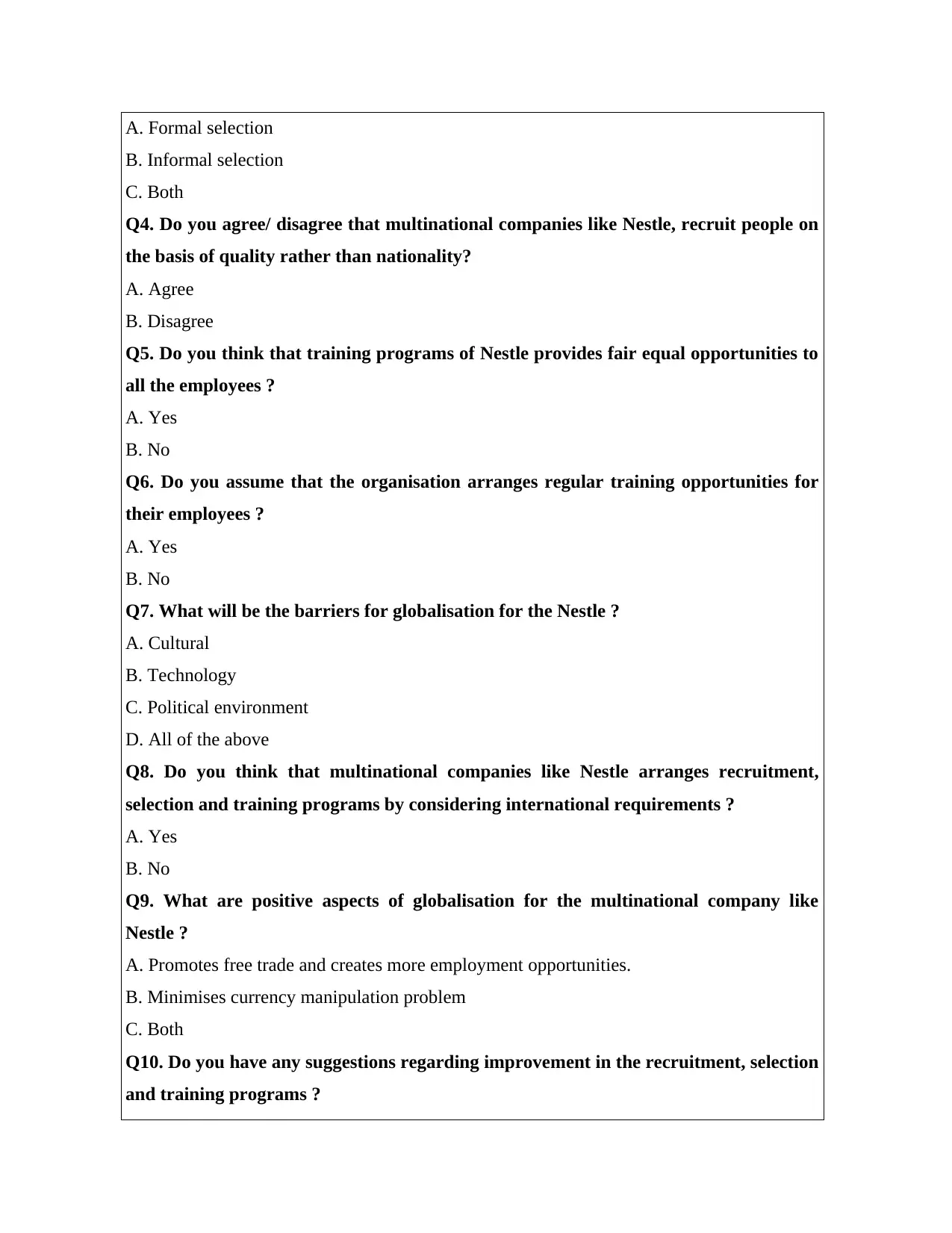
A. Formal selection
B. Informal selection
C. Both
Q4. Do you agree/ disagree that multinational companies like Nestle, recruit people on
the basis of quality rather than nationality?
A. Agree
B. Disagree
Q5. Do you think that training programs of Nestle provides fair equal opportunities to
all the employees ?
A. Yes
B. No
Q6. Do you assume that the organisation arranges regular training opportunities for
their employees ?
A. Yes
B. No
Q7. What will be the barriers for globalisation for the Nestle ?
A. Cultural
B. Technology
C. Political environment
D. All of the above
Q8. Do you think that multinational companies like Nestle arranges recruitment,
selection and training programs by considering international requirements ?
A. Yes
B. No
Q9. What are positive aspects of globalisation for the multinational company like
Nestle ?
A. Promotes free trade and creates more employment opportunities.
B. Minimises currency manipulation problem
C. Both
Q10. Do you have any suggestions regarding improvement in the recruitment, selection
and training programs ?
B. Informal selection
C. Both
Q4. Do you agree/ disagree that multinational companies like Nestle, recruit people on
the basis of quality rather than nationality?
A. Agree
B. Disagree
Q5. Do you think that training programs of Nestle provides fair equal opportunities to
all the employees ?
A. Yes
B. No
Q6. Do you assume that the organisation arranges regular training opportunities for
their employees ?
A. Yes
B. No
Q7. What will be the barriers for globalisation for the Nestle ?
A. Cultural
B. Technology
C. Political environment
D. All of the above
Q8. Do you think that multinational companies like Nestle arranges recruitment,
selection and training programs by considering international requirements ?
A. Yes
B. No
Q9. What are positive aspects of globalisation for the multinational company like
Nestle ?
A. Promotes free trade and creates more employment opportunities.
B. Minimises currency manipulation problem
C. Both
Q10. Do you have any suggestions regarding improvement in the recruitment, selection
and training programs ?
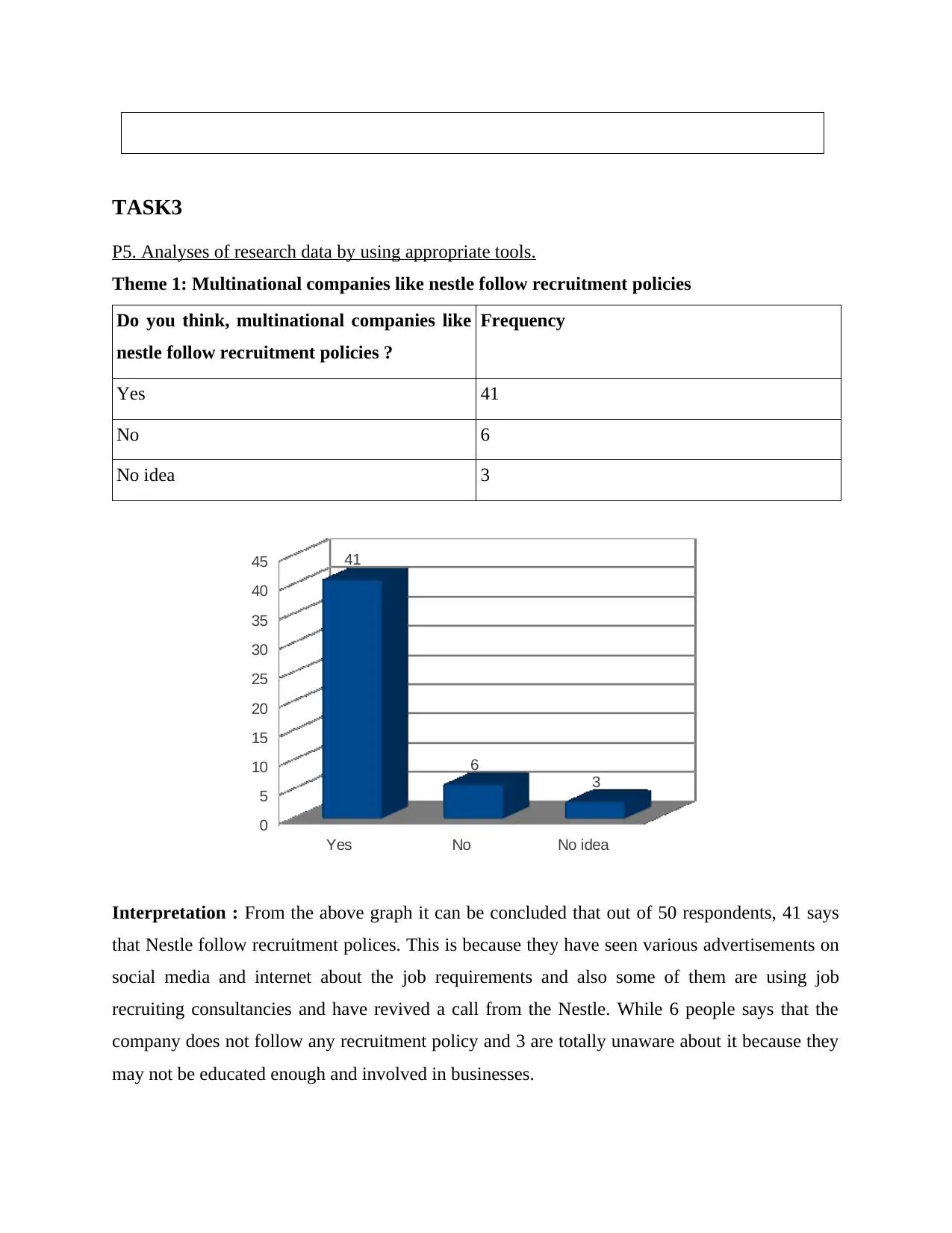
TASK3
P5. Analyses of research data by using appropriate tools.
Theme 1: Multinational companies like nestle follow recruitment policies
Do you think, multinational companies like
nestle follow recruitment policies ?
Frequency
Yes 41
No 6
No idea 3
Interpretation : From the above graph it can be concluded that out of 50 respondents, 41 says
that Nestle follow recruitment polices. This is because they have seen various advertisements on
social media and internet about the job requirements and also some of them are using job
recruiting consultancies and have revived a call from the Nestle. While 6 people says that the
company does not follow any recruitment policy and 3 are totally unaware about it because they
may not be educated enough and involved in businesses.
Yes No No idea
0
5
10
15
20
25
30
35
40
45 41
6
3
P5. Analyses of research data by using appropriate tools.
Theme 1: Multinational companies like nestle follow recruitment policies
Do you think, multinational companies like
nestle follow recruitment policies ?
Frequency
Yes 41
No 6
No idea 3
Interpretation : From the above graph it can be concluded that out of 50 respondents, 41 says
that Nestle follow recruitment polices. This is because they have seen various advertisements on
social media and internet about the job requirements and also some of them are using job
recruiting consultancies and have revived a call from the Nestle. While 6 people says that the
company does not follow any recruitment policy and 3 are totally unaware about it because they
may not be educated enough and involved in businesses.
Yes No No idea
0
5
10
15
20
25
30
35
40
45 41
6
3
⊘ This is a preview!⊘
Do you want full access?
Subscribe today to unlock all pages.

Trusted by 1+ million students worldwide
1 out of 29
Related Documents
Your All-in-One AI-Powered Toolkit for Academic Success.
+13062052269
info@desklib.com
Available 24*7 on WhatsApp / Email
![[object Object]](/_next/static/media/star-bottom.7253800d.svg)
Unlock your academic potential
Copyright © 2020–2025 A2Z Services. All Rights Reserved. Developed and managed by ZUCOL.





